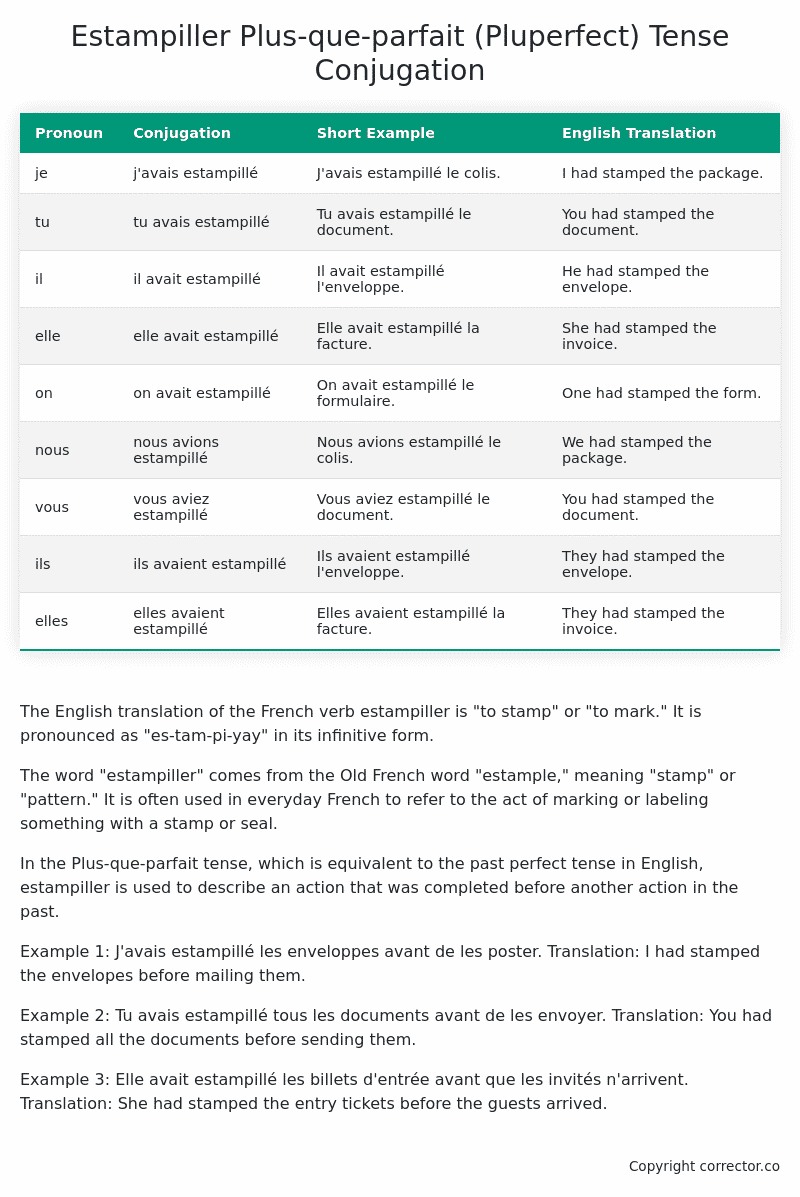Plus-que-parfait (Pluperfect) Tense Conjugation of the French Verb estampiller
Introduction to the verb estampiller
The English translation of the French verb estampiller is “to stamp” or “to mark.” It is pronounced as “es-tam-pi-yay” in its infinitive form.
The word “estampiller” comes from the Old French word “estample,” meaning “stamp” or “pattern.” It is often used in everyday French to refer to the act of marking or labeling something with a stamp or seal.
In the Plus-que-parfait tense, which is equivalent to the past perfect tense in English, estampiller is used to describe an action that was completed before another action in the past.
Example 1: J’avais estampillé les enveloppes avant de les poster.
Translation: I had stamped the envelopes before mailing them.
Example 2: Tu avais estampillé tous les documents avant de les envoyer.
Translation: You had stamped all the documents before sending them.
Example 3: Elle avait estampillé les billets d’entrée avant que les invités n’arrivent.
Translation: She had stamped the entry tickets before the guests arrived.
Table of the Plus-que-parfait (Pluperfect) Tense Conjugation of estampiller
| Pronoun | Conjugation | Short Example | English Translation |
|---|---|---|---|
| je | j’avais estampillé | J’avais estampillé le colis. | I had stamped the package. |
| tu | tu avais estampillé | Tu avais estampillé le document. | You had stamped the document. |
| il | il avait estampillé | Il avait estampillé l’enveloppe. | He had stamped the envelope. |
| elle | elle avait estampillé | Elle avait estampillé la facture. | She had stamped the invoice. |
| on | on avait estampillé | On avait estampillé le formulaire. | One had stamped the form. |
| nous | nous avions estampillé | Nous avions estampillé le colis. | We had stamped the package. |
| vous | vous aviez estampillé | Vous aviez estampillé le document. | You had stamped the document. |
| ils | ils avaient estampillé | Ils avaient estampillé l’enveloppe. | They had stamped the envelope. |
| elles | elles avaient estampillé | Elles avaient estampillé la facture. | They had stamped the invoice. |
Other Conjugations for Estampiller.
Le Present (Present Tense) Conjugation of the French Verb estampiller
Imparfait (Imperfect) Tense Conjugation of the French Verb estampiller
Passé Simple (Simple Past) Tense Conjugation of the French Verb estampiller
Passé Composé (Present Perfect) Tense Conjugation of the French Verb estampiller
Futur Simple (Simple Future) Tense Conjugation of the French Verb estampiller
Futur Proche (Near Future) Tense Conjugation of the French Verb estampiller
Plus-que-parfait (Pluperfect) Tense Conjugation of the French Verb estampiller (this article)
Passé Antérieur (Past Anterior) Tense Conjugation of the French Verb estampiller
Futur Antérieur (Future Anterior) Tense Conjugation of the French Verb estampiller
Subjonctif Présent (Subjunctive Present) Tense Conjugation of the French Verb estampiller
Subjonctif Passé (Subjunctive Past) Tense Conjugation of the French Verb estampiller
Subjonctif Imparfait (Subjunctive Imperfect) Tense Conjugation of the French Verb estampiller
Conditionnel Présent (Conditional Present) Tense Conjugation of the French Verb estampiller
Conditionnel Passé (Conditional Past) Tense Conjugation of the French Verb estampiller
L’impératif Présent (Imperative Present) Tense Conjugation of the French Verb estampiller
L’infinitif Présent (Infinitive Present) Tense Conjugation of the French Verb estampiller
Struggling with French verbs or the language in general? Why not use our free French Grammar Checker – no registration required!
Get a FREE Download Study Sheet of this Conjugation 🔥
Simply right click the image below, click “save image” and get your free reference for the estampiller Plus-que-parfait tense conjugation!

Estampiller – About the French Plus-que-parfait (Pluperfect) Tense
Tense Formation
Common everyday usage patterns
Sequencing of past events
Background information
Hypothetical or reported speech
Interactions with other tenses
Summary
I hope you enjoyed this article on the verb estampiller. Still in a learning mood? Check out another TOTALLY random French verb conjugation!


